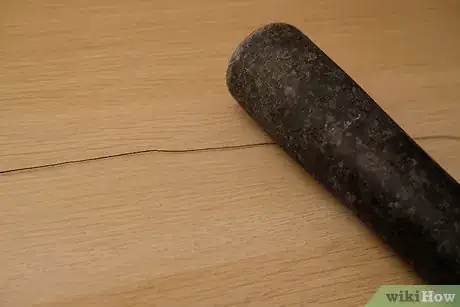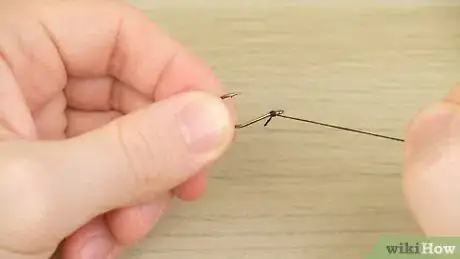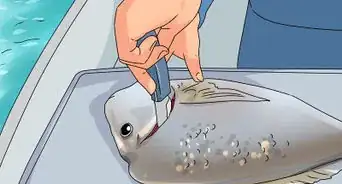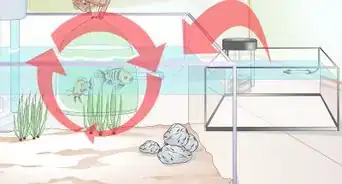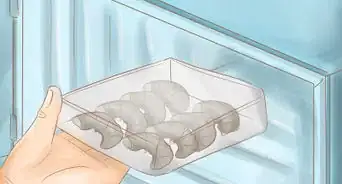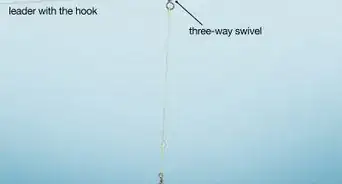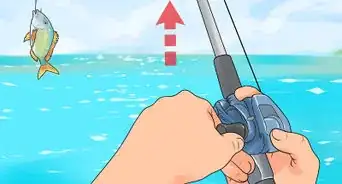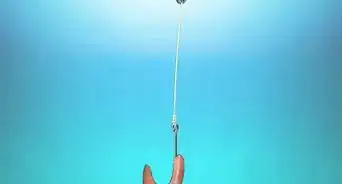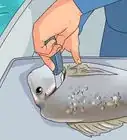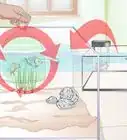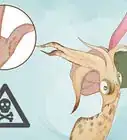This article was co-authored by wikiHow Staff. Our trained team of editors and researchers validate articles for accuracy and comprehensiveness. wikiHow's Content Management Team carefully monitors the work from our editorial staff to ensure that each article is backed by trusted research and meets our high quality standards.
There are 10 references cited in this article, which can be found at the bottom of the page.
The wikiHow Video Team also followed the article's instructions and verified that they work.
This article has been viewed 11,500 times.
Learn more...
A spade hook is a fishing hook that has a spade-shaped end, rather than an eye for you to thread your line through. The main benefit of using a spade hook is that you’ll have a less bulky connection to the line, which will make your bait and lure appear more natural to fish. Because there is no eye, you have to tie your line directly to the shaft of the hook. But have no fear! It’s actually really easy to do, whether you do it by hand, or by using a hook tying device.
Steps
Hand-Tying the Knot
-
1Hold the line along the hook shank and form a small loop near the bend. Hold the fishing line and the shank, which is the straight part of the hook, between your fingers so they’re parallel and there’s about 5–6 inches (13–15 cm) of line past the curve of the hook. Take the tag end, which is the end of the line where you tie your knot, and bring it over the main line to form a small loop near the curve the hook.[1]
- Keep the loop, line, and shank held between your fingers with 1 hand.
-
2Wrap the tag end of the line around the hook shank and line 8-10 times. Holding the shank and main line parallel with each other, take the tag end and wrap it around both of them near the spade end of the hook. Keep the tag end taut and wrap it around the shank and line at least 8 times.[2]
- The spade end is the top of the shank of the hook.
- Don’t allow any slack in the main line or the tag end so the knot is formed properly.
Advertisement -
3Insert the tag end through the loop at the bottom of the hook. Bring the tag end through the small loop at the bottom near the shank and pull it all the way through. Keep the shank pinched between your 2 fingers so the line stays tight.[3]
-
4Pull the main line slowly to tighten the knot. Release the shank of the hook and hold it by the curve at the bottom. Take hold of the main line and gently pull the line to finish the knot. When the knot is finished, pull the main line hard to tighten the knot even further.[4]
- The knot must be tight so it won’t slip off of the hook.
-
5Cut off the excess length of the line at the tag end. Take a knife, a pair of scissors, or nail clippers and trim away the tag end of the line. Cut the extra length of line so the tag end is flush with the knot and won’t drag in the water.[5]
Tip: If you’re using braided line, use scissors to trim the tag end. A knife or nail clippers won’t cut the line evenly.
Using a Hook Tyer
-
1Clamp the hook onto the tyer so the shank is pointing up. Place the curve of the hook between the jaws on the top of the hook tying machine. Rotate the dial clockwise to tighten the jaws and clamp the hook in place so the shank is sticking out of it.[6]
- Make sure the hook is clamped tightly and doesn’t move between the jaws.
-
2Push the 2 metal pins all the way through the tyer. Around the adjustment dial are 2 metal pins. Push the pins all the way through the tyer so they’re sticking out of the opposite side.[7]
- The crossbar of the 2 pins will be flush against the surface of the tying machine when you push them through.
-
3Place a weight on the main line to anchor it in place. Use a weight, rock, brick or another heavy object to anchor the main line about 2–3 feet (0.61–0.91 m) from the tag end of the line. Make sure the weight is stable and hold the line taut so you can easily form your knot.[8]
Tip: The reel of your fishing rod can serve as an anchor if the line is already spooled on it, but make sure the rod won’t move while you’re tying your knot.
-
4Loop the tag end of the line over the bottom pin. Take the tag end of your line and wrap it beneath the lower metal pin on the tyer. Keep the line taut and hold the tyer so the main line is parallel to the shank of the hook.[9]
-
5Pull the tag end over the shank of the hook and the main line. Take the tag end of the line and bring it over the shank of the hook and the main line so it’s resting on top of both of them. Keep all of the lines held tautly.[10]
-
6Rotate the tier counterclockwise 6-7 times to wrap the line around the shank. Pull on the tag end with 1 hand to keep the line tight and turn the tyer to start wrapping it around the shank of the hook and the main line. Continue rotating the tier at least 6 times to great a strong knot.[11]
- Use 6 wraps for thicker line so it won’t slip off of the hook.
- For thinner fishing line, wrap it around 7-8 times to create a stronger knot.
-
7Wrap the tag end over the top pin and push the pins down. Take the tag end of the line and run it beneath the upper metal pin on the tyer. Pull it toward the shaft of the hook to keep the line tight. Then, push both of the pins through the tyer so they’re back to their original position.[12]
- The top pin will hold the line against the tyer to form a small loop.
-
8Tighten the knot by pulling on the main line. With the upper pin holding the tag end of the line, release the tag end from your hand and take hold of the main line. Slowly pull it tight so the knot can settle into place evenly.[13]
- Don’t jerk or yank the line or the knot will come together unevenly.
-
9Remove the hook from the tyer and pull the lines to tighten the knot. Pinch the shaft of the hook and the line with your fingers and rotate the adjustment dial to loosen the jaws holding the hook. When they’re loose enough, remove the hook and pinch the curve of the hook between your fingers to hold it. Pull on the main line to tighten the knot even further.[14]
-
10Trim the extra length of line away from the tag end. Use a knife, a pair of scissors, or nail clippers to cut away the tag end. Trim the line so it’s completely flush with the knot and there isn’t any thread that will be free-floating in the water.[15]
References
- ↑ https://www.takemefishing.org/how-to-fish/fishing-knots-and-rigs/lure-and-rig-fishing-knots/
- ↑ https://youtu.be/sX_OKR_sKJg?t=31
- ↑ https://youtu.be/5WQ5h3n9FVg?t=125
- ↑ https://www.takemefishing.org/how-to-fish/fishing-knots-and-rigs/lure-and-rig-fishing-knots/
- ↑ https://www.takemefishing.org/how-to-fish/fishing-knots-and-rigs/lure-and-rig-fishing-knots/
- ↑ https://www.anglingtimes.co.uk/advice/rigs/articles/how-to-tie-a-spade-end-hook
- ↑ https://youtu.be/DHrAIOU9Lrs?t=22
- ↑ https://www.anglingtimes.co.uk/advice/rigs/articles/how-to-tie-a-spade-end-hook
- ↑ https://www.anglingtimes.co.uk/advice/rigs/articles/how-to-tie-a-spade-end-hook
